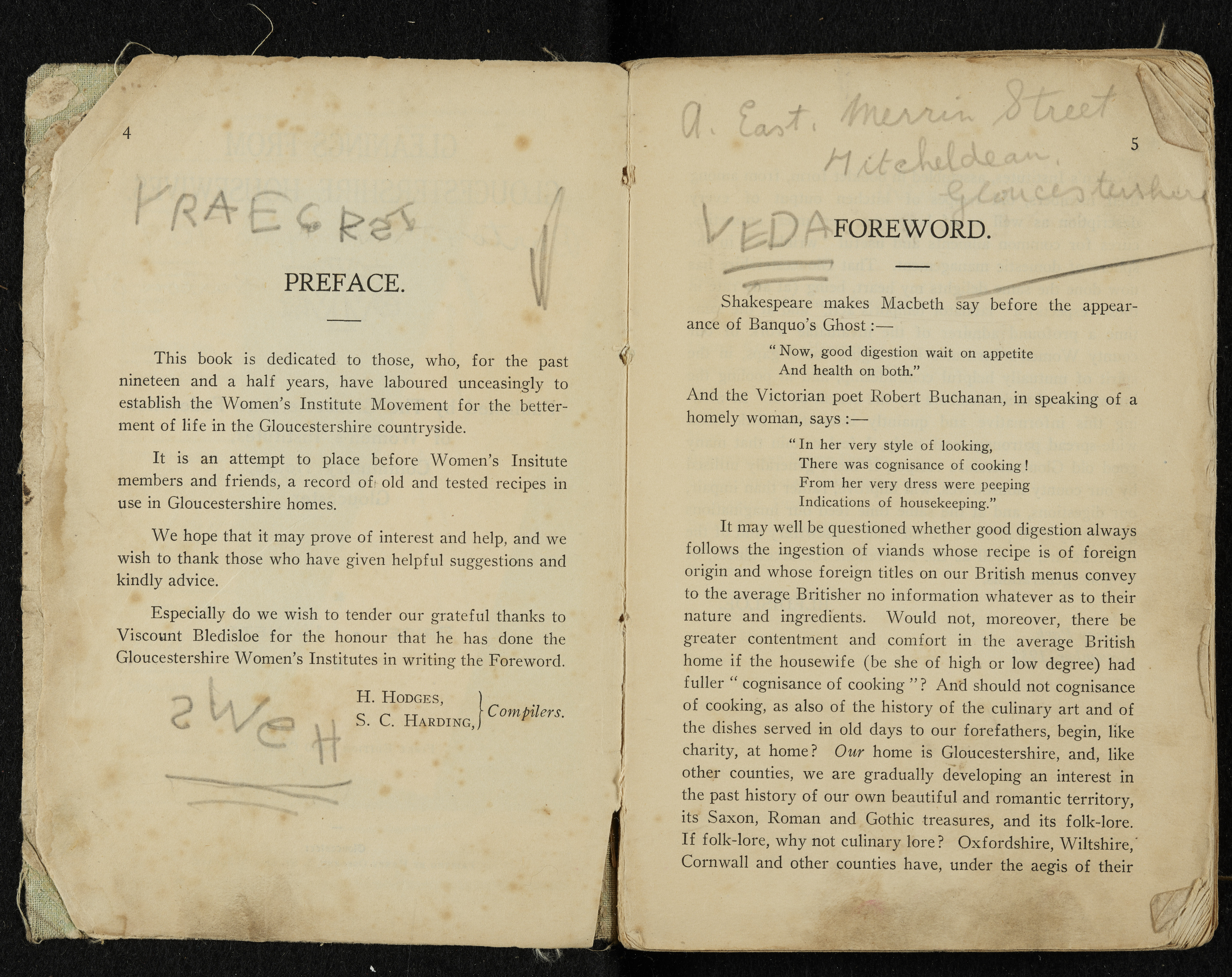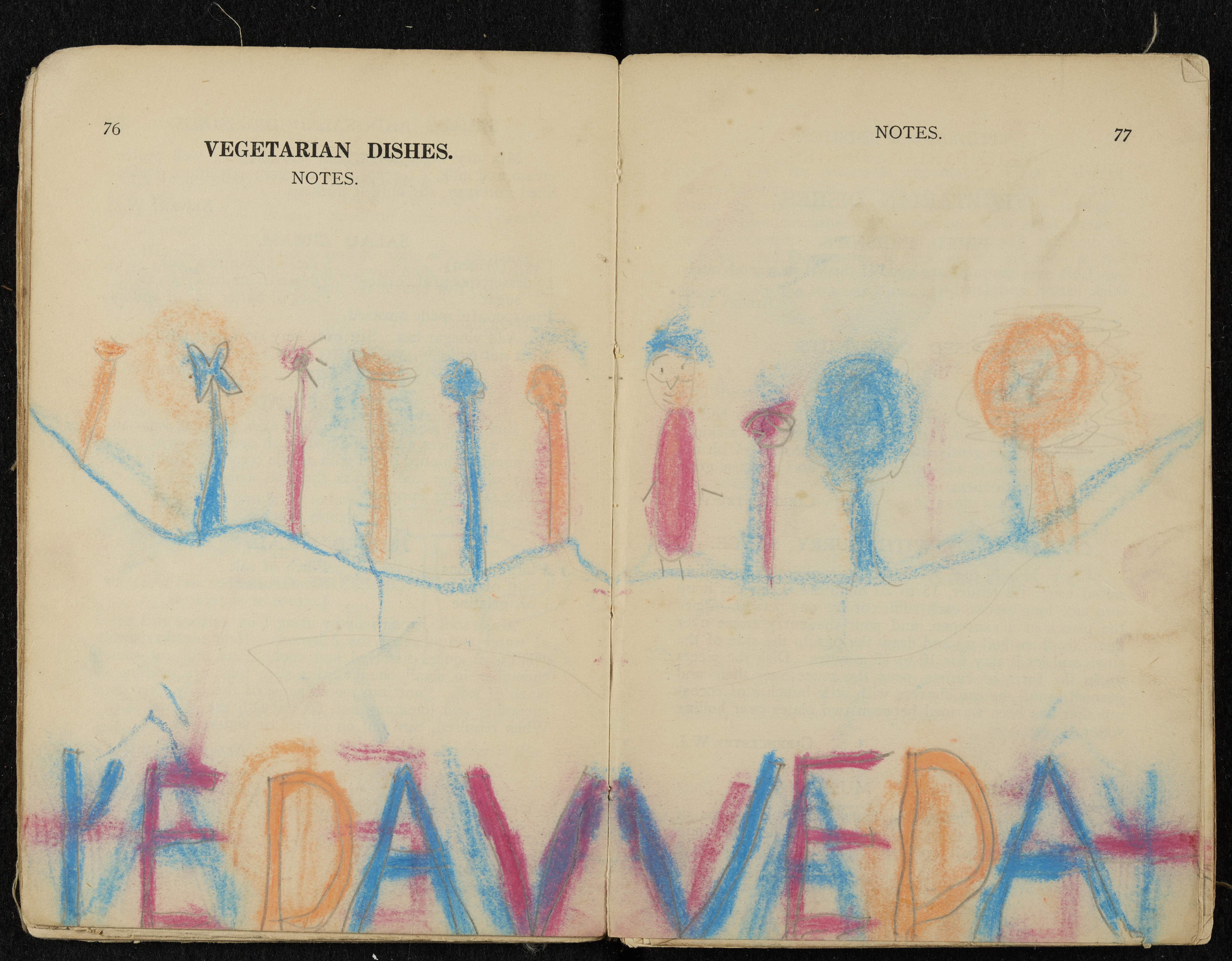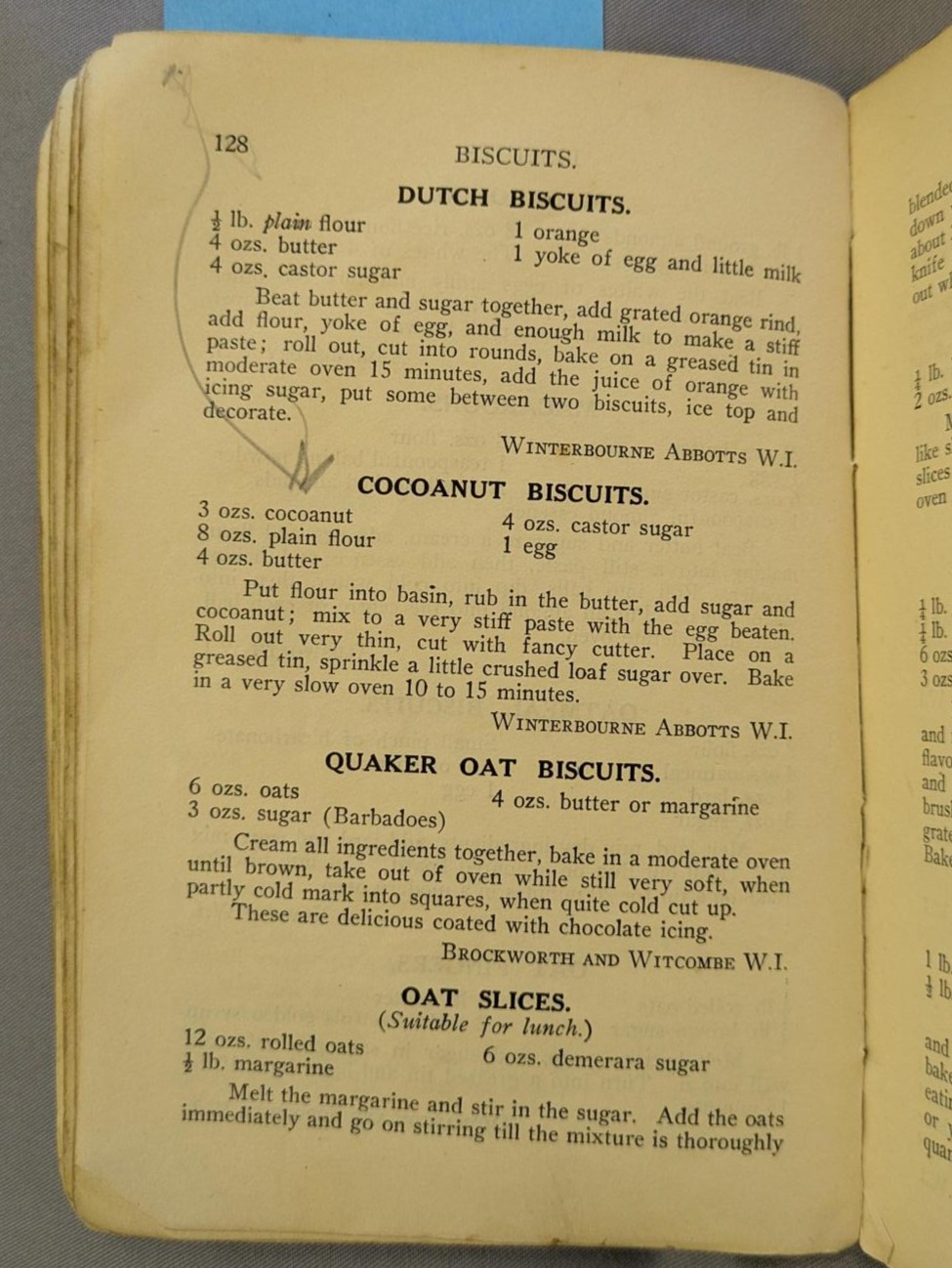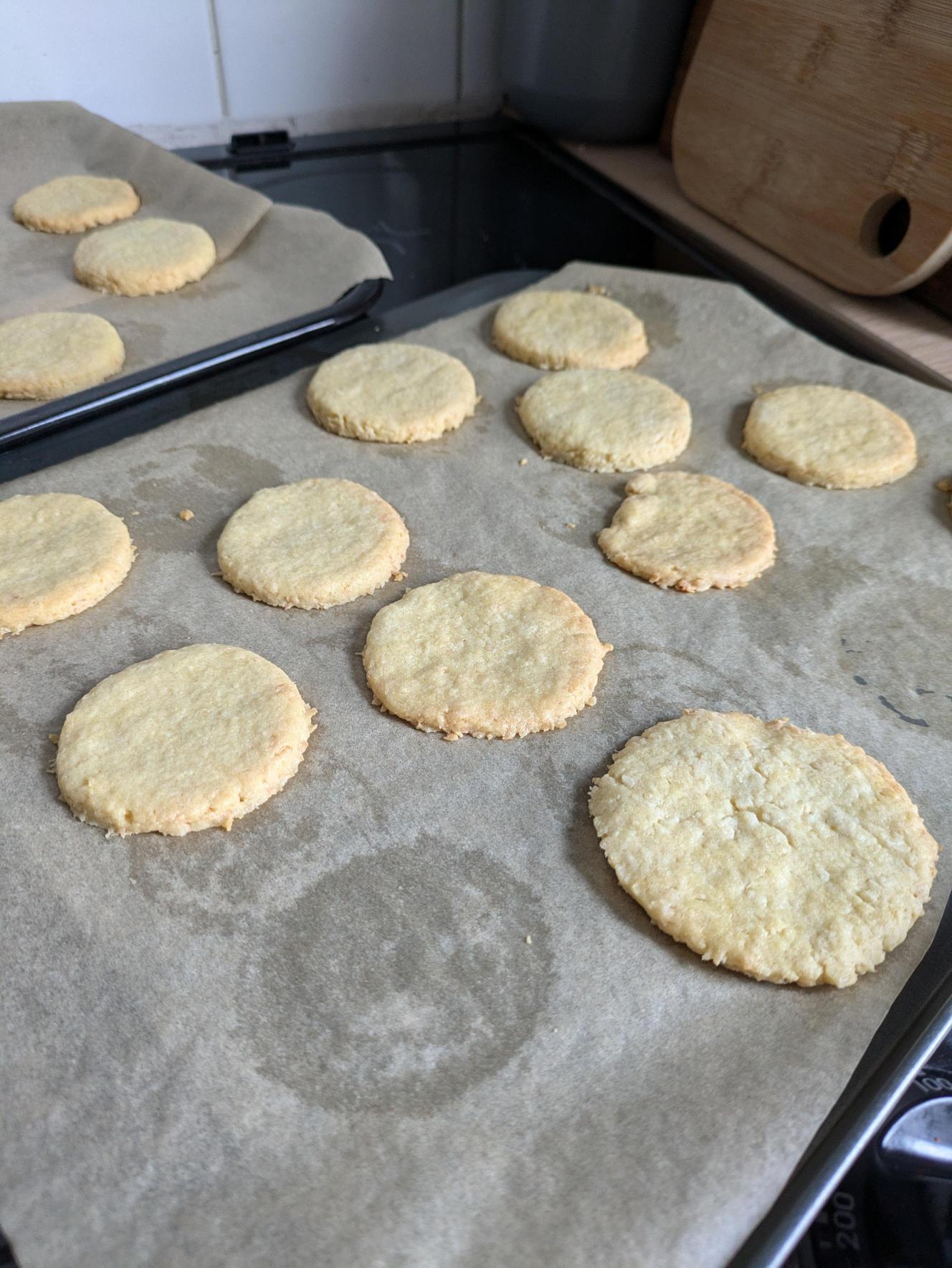Cataloguing Archivist Hollie Piff puts her cooking skills to the test and explores the Domestic section of the Hypatia Collection, using the scribbles and scrawls of past owners to identify favourite recipes.
At the University of Exeter Special Collections we carefully monitor readers in the Reading Room; no food or drink is allowed, and marking the rare books and archives with pencil or pen is strictly forbidden. The Reading Room is clean, as are the hands of readers (we hope), and all that breaks the silence of the space is the quiet swishing of turning pages.
The archive and rare books material, despite its orderly cataloguing and rehousing in acid-free folders, has often led a more chaotic former life. Cookbooks, in particular, serve as windows into the daily lives of the people who owned them, often including annotations, corrections, and clippings from newspapers or magazines. Sometimes, singed corners and food stains mark favourite dishes, and handwritten recipes on yellowed paper demonstrate the exchange of food and tradition between friends and family.
On rolling shelves in Special Collections stand thousands of books from the Hypatia collection of journals, books, pamphlets, and periodicals by and about women. I am particularly interested in the domestic science section, which is peppered with cookbooks from the 19th and 20th centuries with enticing titles such as Good cookery!, New ways of using custard, and Have herrings: in all these delicious ways.
These books are fantastic records of changing tastes and trends over the last two hundred years, but can they really tell us what ordinary people cooked and ate day-to-day?
Ken Albala explains that, as examples of “prescriptive literature”, “cookbooks are rarely if ever accurate descriptions of what people actually ate at any given time and place” (‘Cookbooks as Historical Documents’). But, he adds, “comments, corrections to a recipe, or additions are positive evidence that someone interacted directly with the text and actually cooked the recipe” (Albala). The Hypatia cookbooks contain scribbles, names, handwritten recipes and other marks in pen and pencil, and by studying these marks of ownership and authorship, we can understand how people interacted with their cookbooks, what they cooked, ate, and fed their families.
Gleanings from Gloucestershire Housewives
Gleanings from Gloucestershire Housewives was initially collated and published by the Gloucestershire Federation of Women’s Institutes in 1927. The book contains recipes from W.I.s across Gloucestershire, from Badminton Eggs in Cirencester to Almond Jumbles in Almondsbury, which paint a rich picture of the tastes and customs of local women. Our copy from 1935 is well worn, with a threadbare green cover darkened by mysterious stains.

An inscription in neat cursive on the front page names the owner of the book: A. East, from Mitcheldean, Gloucestershire. Despite not leaving her full name, this simple mark of ownership, Janet Theophano suggests, is “an act of autobiographical writing,” an attempt by women to write themselves into the historical record and leave evidence of their work behind (Eat My Words 122). The writing in Gleanings from Gloucestershire Housewives does far more than leave evidence of “work”, its pages are full of creativity, learning and – most importantly – fun, and we have Veda to thank for that.

Veda, who I can only assume was the young daughter or granddaughter of A. East, dominates the pages of this cookbook with her doodles, scribbles, and writing practice. In pencil and colourful chalk, Veda practices writing her name (“VEDAVEDAVEDA”), draws vibrant abstract landscapes, and captures the likenesses of her friends and family. The intended purpose of the book does not deter Veda, in fact, the interactivity of the cookbook form invites personalisation, and its “ordinariness” captures snapshots of daily life in a rather less self-conscious way than a diary or scrapbook might.

There are many handwriting styles in the book, which either suggests that Veda had several siblings or, as I like to imagine, she used Gleanings from Gloucestershire Housewives as an inadvertent diary over several years. Veda’s insertions start as ham-fisted scribbles but slowly develop into identifiable letters, pictures of houses, and eventually legible words and sentences; on page 96 she writes in unsteady cursive, “you are my sun shine”.
Veda was, we assume, watching her mother prepare food and, while doing so, learnt to read, write, and cook. In the hands of Veda, Gleanings from Gloucestershire Housewives has become a work of autobiography, and now, nearly one hundred years later, we can connect with the playful evidence of its use.
But surely, the best way to connect with cooks of the past isn’t to read, but to cook! (And, most importantly, to eat.)
Ready, steady…
It seems from other cookbooks in the collection that a neat pencil tick beside the title of a recipe marks it out as a success: a personal favourite, perhaps, or an experiment that went surprisingly well. It is difficult to establish whether Veda’s scribbles mark recipes out as personal favourites or as dishes she wishes to scrub from her mother’s repertoire, so I had to get creative when choosing a recipe to cook up myself.
A winding, wiggling arrow on page 128 points to a recipe for ‘Cocoanut Biscuits’ from Winterbourne Abbotts W.I. group. The recipe seemed simple enough and was certainly more appealing than ‘Jellied Salad’, so I bought the ingredients, enlisted the help of my own Veda (aka my fiancé) and got cooking.

When I say I “bought the ingredients”, what I really mean to say is that I saw a full jar of desiccated coconut in the kitchen cupboard and naively assumed, since that was the most unique ingredient of the bunch, that I would certainly have enough of everything else. Of course I was wrong, but I didn’t know that quite yet.
While I cast myself as the ever-capable Mrs. East in this scenario, the roles were reversed quite quickly when it came to sieving flour. The recipe called for us to just “add the flour”, so in the true historical spirit of the recipe (read laziness) I decided there was no need to sieve. Perhaps there was no need, but my sensible sous chef sieved, nonetheless.
Next, we added the butter. All of the butter. Every last scraping of butter from the butter dish, and still we fell short. Nothing a few glugs of vegetable oil couldn’t fix! We combined the flour, butter, and oil with our fingers before mixing in the desiccated coconut. Incredibly I had the perfect amount, and it was at this point that I believed my luck had turned. The recipe then called for 4 oz. of caster sugar and one beaten egg. Eggs were not a problem, so I beat one in a separate bowl and added it to the mixture. Unfortunately, the sugar wasn’t quite as simple.
At the back of the cupboard, squirrelled away behind an absurd selection of flours, I found a third of a miniature bag of golden caster sugar. We had clearly learnt nothing about imperial measurements, so we were shocked when the numbers on the electric scale ticked up to a grand total of 1.5 oz. We needed 4 oz. of sugar and, despite my fiancé’s absurd recommendations, I refused to substitute in dark brown sugar. After a quick dash to the local shop for a tiny bag of caster sugar (which set me back a whole £2.40) we were back on track.
We mixed everything together until it formed a “stiff paste,” and then attempted to roll the dough out thinly. Unfortunately, it was quite warm in the kitchen so the dough was sticking and tearing as we rolled it out. We decided to put it on a baking tray and, after playing some fridge Tetris, let it cool for around fifteen minutes.
Once chilled, we cut the biscuits out using the rim of an old sun-dried tomato jar (thoroughly cleaned) and arranged them on a greaseproof paper-lined baking tray before popping them in the oven at around 150-160C for 15 minutes.

When the time was up, we retrieved our biscuits from the oven and left them (impatiently) to cool. As I took my first bite I realised quite suddenly that these ‘Cocoanut Biscuits’ were in fact, Nice biscuits, a personal favourite of the Special Collections team. They were lovely and coconutty, not overly sweet, and had a satisfying snap. I brought some of the biscuits into the office to share with colleagues and they seemed to go down well—despite a few colleagues choking on desiccated coconut.
Conclusion
Although the splatters, stains, annotations and inserts in the Hypatia books aren’t mentioned in the library catalogue, I believe they are vital to accessing the stories of the women who owned these books. These pages are testament to their likes and their dislikes, their creativity and curiosity, the lives of their families, and the growth of their children; squirrelled away amongst recipes for sausage rolls and fruit cake. By reading these books, and cooking well-loved recipes, we can reconnect with the past and (more often than not) enjoy a delicious sweet treat in the name of research!
To learn more about the Hypatia Collection, explore our website!
Works Referenced
Albala, Ken, ‘Cookbooks as Historical Documents’, in Jeffrey M. Pilcher (ed.), The Oxford Handbook of Food History, Oxford Handbooks (2012; online edn, Oxford Academic, 21 Nov. 2012), https://doi.org/10.1093/oxfordhb/9780199729937.013.0013, accessed 17 Mar. 2025.
Theophano, Janet. Eat My Words : Reading Women’s Lives through the Cookbooks They Wrote. Palgrave, 2002.